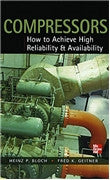Description
Written by experts with more than 100 combined years of industry experience in machinery failure avoidance, Compressors: How to Achieve High Reliability & Availability offers proven solutions to a pervasive and expensive problem in modern industry - compressor failure. This succinct, on-the-job guide addresses elusive causes of compressor failure and clearly maps out permanent remedies you can put to use right away. With a focus on centrifugal and reciprocating compressors, this accessible reference is based on real-world processes and procedures used by successful global companies.
Author: Heinz P. Bloch and Fred K. Geitner
Published: 2012
Format: Hardback
Pages: 268
Table Of Contents:
1. Introduction, Compression Principles, and Internal Labyrinths
Density and Compression Ratios
Heat and Mass Concepts Simplified
The Concept of "Head" and Other Parameters
Positive Displacement versus Dynamic Compressors
Internal Labyrinth Seals
Preinvesting with Future Uprating in Mind
What We Have Learned
2. Selection Factors for Process Compressors
What We Have Learned
3. Operating Characteristics of Turbocompressors
Surge
Compressor Speed
Inlet Pressure and Temperature
Effect of Gas Properties
Effect of Speed Changes
Changing Suction Temperature
What We Have Learned
4. Wet and Dry Gas Seals for Centrifugal Compressors
The Case against Wet Seals
How Gas Seals Function
Minimizing the Risk of Sealing Problems
Seal Safety and Reliability
Making Good Choices
What We Have Learned
5. Bearings, Stability, and Vibration Guidance
Mechanical Design
Destabilizing Forces and Aerodynamic Cross Coupling
Fractional Frequency Activity in Bearings
Examining What Can Be Done about Instability
Thrust and Radial Tilt Pad Bearings
Bearing Clearances
Vibration and Acceptable Limits
What We Have Learned
6. Lube and Seal Oil Systems
Layout Guidance
Examine What Often Goes Wrong
What We Have Learned
7. Impellers and Rotors
Construction, Inspection, and Repair of Impellers
What We Have Learned
8. Compressor Maintenance and Surveillance Highlights
Preventive and Predictive Maintenance Explained
Compressor Maintenance in Best Practices Plants
Emergency Repairs Should Be Minimized
Effectiveness of Selective Preventive Maintenance
Know Your Existing Program
Maintenance Improvement
What We Have Learned
9. Inspection and Repair Guidelines for Rotors
Phase I (Initial Preparation)
Phase II (Repairs)
Phase III (Assembly and Balancing)
PHASE IV (Preparation for Storage or Shipment)
What We Have Learned
10. Machinery Quality Assessment
Detailed Specifications Are Needed
Briefing Project Executives on MQA
Only Competent Manufacturers Are Invited to Submit Bids
What We Have Learned
11. Compressor Failure Analysis Overview
Case History Dealing with Impeller Failure
What We Have Learned
12. Reciprocating Compressors: Background and Overview
Introduction
Basic Operating Principle Explained
Downstream Process Reciprocating Compressors: Major Components
What We Have Learned
13. Compressor Operation and Capacity Control
Starting Reciprocating Compressors
Performance Control and Throughput Adjustment
Multiple Services
Calculations
Basic Equations
What We Have Learned
14. Reciprocating Compressor Maintenance
Compressor Cylinder
Noise and Vibration
Frame (Crankcase) Repair Practices
What We Have Learned
15. Maintenance and Operations Interfaces
Shutdowns
Monitoring and Record Keeping
Cleanliness and Tools
Major Overhaul Checklist for Reciprocating Compressors
What We Have Learned
16. Surveillance, Monitoring, and Troubleshooting Reciprocating Compressors
Surveillance
Monitoring
Quick Troubleshooting Guide
17. Reciprocating Compressor Upgrading, Rebuilding, and Remanufacturing
Inspection, Overhaul, and Repair
Rebuilding
What We Have Learned
18. Training Competent Compressor Engineers
Role Statement and "Phase One" of In-House Training
The Structure of Training
"Phase Two" Training: Digging Up the Facts
Training Plans Beyond Phases I and II
Putting the Training to Practice
What We Have Learned




